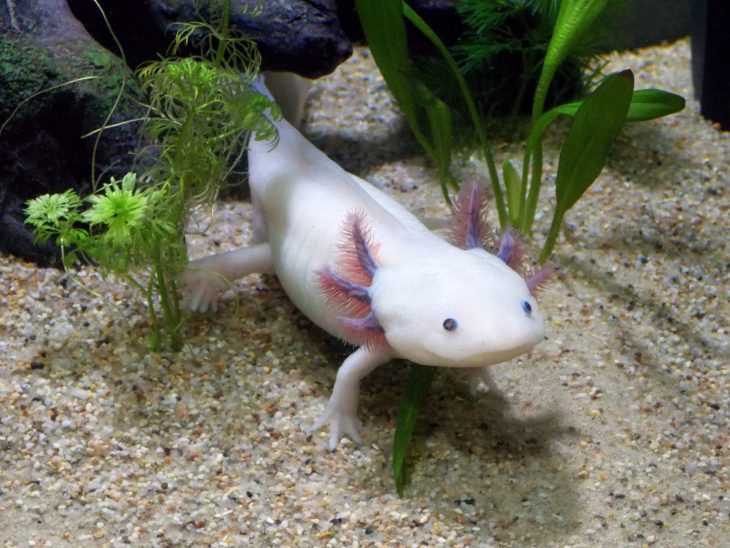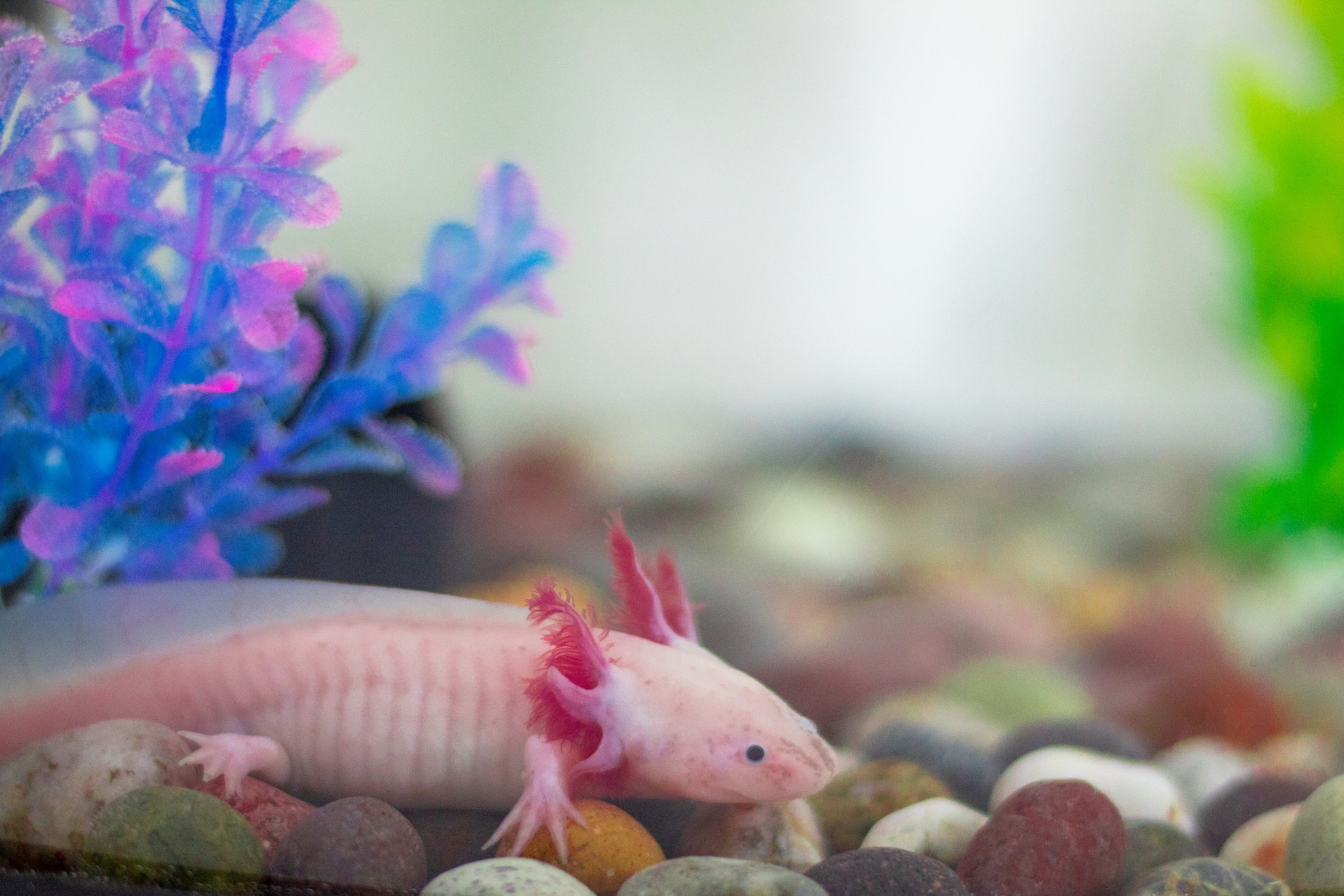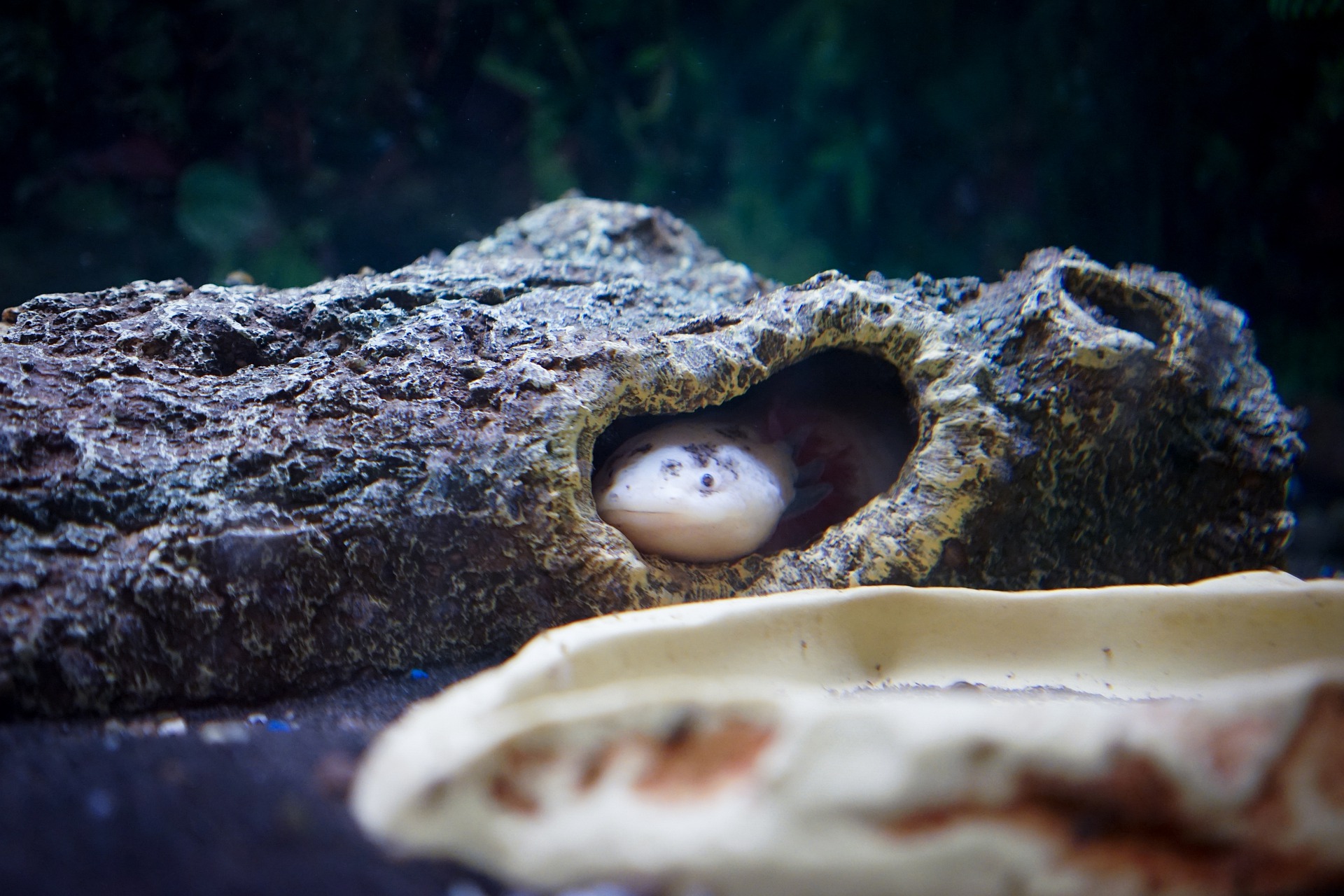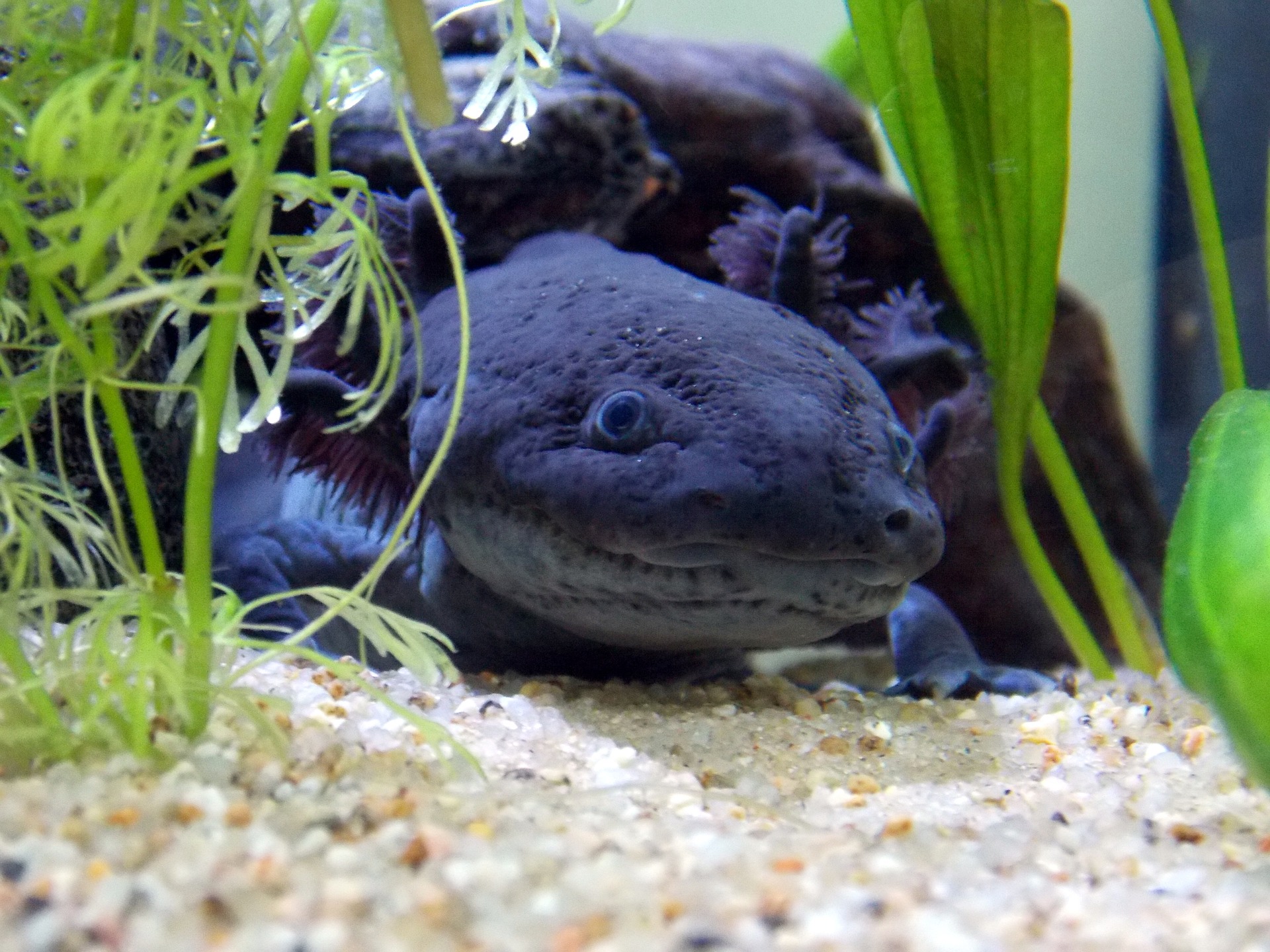
Donning lizard-like bodies, distinct fringes at the side of their heads, and adorable smiles, axolotls are strange little creatures. These amphibians are popular exotic pets. Also, their abilities are the subject of much scientific research. Find out all there is to know about these amazing animals with these axolotl facts.
- Axolotls grow to an average length of 9 in (20 cm) but large individuals can reach lengths of up to 12 in (30 cm). They weigh around 2 to 8 oz (56–226 g).
- These amphibians reach sexual maturity at around 18 to 24 months of age.
- Axolotls can reach top swimming speeds of up to 10 mph (15 km/h).
- In 2020, the Bank of Mexico announced that Mexico’s 50-peso banknote is set to feature the axolotl in 2022.
- Julio Cortázar’s 1956 collection Final del juego includes the short story “Axolotl”, which follows the story of a man who became obsessed with axolotls.
- Axolotls have finned tails and webbed feet.
- They are sometimes referred to as Mexican walking fish due to their appearance.
- Although they resemble fish, axolotls are amphibians.
- Axolotls are a type of salamander.
- They can only live in freshwater habitats.
- The scientific name of the axolotl is Ambystoma mexicanum.
- Female axolotls have bodies that are rounder and plumper, while males tend to have slender and more streamlined bodies.
- Like most amphibians, they use a single opening to defecate, urinate, and reproduce. This opening is called a cloaca.
- Male axolotls have enlarged cloacas that appear swollen, while females have smaller cloacas.
- Axolotl eyes are spread wide apart and lack eyelids.
- Axolotls exhibit electroreception, which means that they have the ability to detect electrical fields.
- They are generally solitary creatures and typically only interact to mate.
- Their skeletons are mostly made up of cartilage.
- They have a limited ability to change their colors to better blend in with their environment.
- Yolanda Buenaventura from the Netflix series BoJack Horseman is an anthropomorphic axolotl.
Their name means “water dog” and stems from the name of an Aztec god.
Axolotl is pronounced as “AX-o-lot-ul”, and it rhymes with “bottle”. The term axolotl originates from the Aztecs’ Nahuatl language, and it’s a combination of “atl” (water) and “Xolotl” (dog or servant).
In Aztec mythology, Xolotl was actually the god of fire, lightning, deformities, diseases, and death. This dog-headed god was the twin brother of the flying serpent Quetzalcoatl. As the god of death, he guided the souls of the dead to the underworld. Xolotl was also a master of disguise, apparently transforming himself into various plants and animals. He has two spirit animal forms, which are the Xoloitzcuintli dog and the axolotl.
Axolotls can regenerate limbs and even vital organs.
One of the most interesting axolotl facts is that they have incredibly impressive regenerative powers. The regenerative abilities of axolotls allow them to regrow lost limbs, tails, spines, jaws, eye tissues, and even parts of vital organs such as their hearts and brains. Unlike most vertebrates, they show no signs of scarring and can fully heal themselves over the course of a few months.
Human children can regenerate lost fingertips, and mice can do this as well to some extent. However, salamanders such as axolotls take it a step further. They are the only vertebrates that have the ability to regenerate whole limbs and show no signs of scarring. Although they can repeatedly regrow lost limbs over the course of their lives, this ability has its limits. The limbs usually stop growing back after five times.
Occasionally, an axolotl may grow a limb while it regenerates an injured limb. This can result in the individual having an extra limb, which pet keepers covet because of its novelty.
The feathery fringes beside their heads are gills.

Axolotls sport distinctive feathery frills at the side of their heads. Although they look like decorative headdresses, these fringes are actually the axolotl’s external gills. Axolotls remain in the water their whole lives and use these gills to breathe underwater. Axolotls have three pairs of gill stalks, and the feathery filaments on these gill stalks serve to increase the surface area for more efficient gas exchange.
The external gills aren’t the only organs that axolotls use to breathe; researchers speculate that axolotls actually have four methods of breathing. Like all amphibians, the axolotl can also breathe through its skin. Their thin skin membranes allow them to exchange gases with their environment. Axolotls can also use membranes near the back of their throats to extract oxygen from the water. Finally, axolotls have underdeveloped lungs that they sometimes use when taking a gulp of air on the surface of the water.
Tiger salamanders are their closest relatives.
Although they look similar to mudpuppies, another type of fully aquatic salamander, they are not closely related. The closest relatives of axolotls are actually Mexican tiger salamanders (Ambystoma tigrinum), which are among the largest salamanders in North America.
Young tiger salamanders, or “waterdogs”, look very similar to axolotls. The two species can even produce viable offspring, leading some scientists to believe that axolotls are merely a subspecies of the tiger salamander. However, some experts contend that the axolotl is distinct enough to be its own separate species.
Axolotls have an extreme case of “baby face”.
Perhaps one of the most distinctive features that set axolotls apart from tiger salamanders is that axolotls retain their juvenile appearance throughout their whole lives. Like most amphibians, tiger salamanders undergo metamorphosis when they reach adulthood. Through this process, they move from an aquatic lifestyle into a terrestrial one. The larvae or “waterdogs” lose their gills and fins and begin to have well-developed lungs and legs to adapt to life on land.
Axolotls, however, do not transform into these adult forms. They’re a classic example of neoteny, an adaptation that entails a delay in the physical development of the species. This means that axolotls keep their larval appearance even as they reach sexual maturity. They even reproduce in their larval appearance. Neoteny is quite a common adaptation in salamander families, as it likely acts as a survival mechanism.
They’re not completely incapable of metamorphosis.
Axolotls can undergo metamorphosis under certain conditions. Other salamanders that exhibit neoteny (such as mudpuppies and sirens), on the other hand, are unable to do this. Researchers postulate that the lack of metamorphosis among axolotls is due to the lack of hormones that stimulate the thyroid. Upon injection of iodine or thyroxine hormones, however, they undergo metamorphosis and lose their larval appearance.
Their appearance after metamorphosis looks similar to that of adult tiger salamanders, with a few physical differences such as longer toes. Metamorphosis among axolotls is quite dangerous, however, because their regenerative abilities diminish when they metamorphose. Moreover, axolotls typically die shortly after undergoing metamorphosis.
They are the top predators in their natural habitats.
Although they don’t look like it, axolotls are carnivorous amphibians and are the top predators in their home range. Upon the introduction of invasive carnivorous fish, however, they started facing fierce competition in the wild. The typical axolotl diet consists of mollusks, worms, insects, and small fishes.
Axolotls ingest small stones to break down their food.

The teeth of axolotls are underdeveloped, and they rely on suction to ingest their food instead of biting and chewing. Oftentimes, axolotls ingest small pieces of gravel when they suck in and swallow their food. This isn’t typically dangerous, however — quite the contrary. Axolotls don’t chew their food, so they use these small stones to break down their food into smaller pieces. This aids in their digestion and also helps weigh them down while feeding underwater.
Axolotls are popular in the pet trade.
Although they’re extremely rare in the wild, it’s not uncommon to find exotic pet keepers to have a pet axolotl. These adorable amphibians breed readily in captivity and tend to be inexpensive to feed. They can eat a wide variety of foods in captivity, such as insects, bloodworms, earthworms, pelleted food, waxworms, and small feeder fish.
Axolotls thrive in still waters and can live in a freshwater aquarium that does not have a strong-flowing filter. Because axolotls can get quite large, a single individual requires at least 6 in (15 cm) of water in a 10-gallon (40 L) aquarium.
They spend most of their time at the bottom of tanks, and experts suggest that fine sand is the best substrate for them. Because they swallow some of their bedding material when they eat, small and sharp stones should not be used in the aquarium. This could lead to injuries and other severe problems.
They thrive in cold waters.
Axolotls are cold-blooded animals whose body temperatures rely on their environment. In their home range, the water temperatures do not typically exceed 68 °F (20 °C), and the temperatures can even drop lower than 42.8°F (6°C) in the winter. Thus, axolotls are adapted to thrive in cold waters.
When keeping a pet axolotl, the water temperature should be between 61°F (16°C) and 64°F (18°C) to ensure proper feeding and metabolism. If the temperature is too low, axolotls may not eat much and can have an unhealthily slow metabolism. On the other hand, if the temperature is too high, the axolotls may suffer from stress and metabolic diseases as well. These conditions could be fatal to them, so it’s important to ensure proper water temperatures.
This article belongs to Facts.net and may not be reproduced, copied, edited, published, transmitted, or uploaded in any way without the permission of Facts.net.
Axolotls come in different colors.

In the wild, axolotls typically sport a mottled brown or tan coloration with golden speckles and olive undertones. This coloration helps them blend in with the bottom of the lakes they inhabit. Captive axolotls, however, come in various colors.
They have four pigmentation genes that mutate and result in different color forms. Albino axolotls lack pigmentation entirely and are white with red or pink eyes and gills. Leucistic axolotls only partially lack pigmentation and are pale pink with black eyes. Melanoid axolotls are completely black. Some albino axolotls may also have golden hues to them, which are highly desirable in the pet trade.
The axolotl can live for up to 15 years.
Typically, captive axolotls live between 5 and 6 years, although some individuals reportedly reach ages of up to 10 to 15 years. Their lifespan in the wild tends to be much shorter because of the environmental dangers. Storks, herons, carnivorous fishes, and fellow axolotls also may prey on them.
Axolotls are resistant to cancer.
Aside from having impressive regenerative abilities, axolotls also rarely develop cancer. Compared to mammals, axolotls are over a thousand times more resistant to cancer and tumor formations. Truly one of the most astounding axolotl facts you have to remember!
Their body readily accepts organ transplants.
Axolotls readily accept organ transplants and quickly restore the organs’ functions. Scientists have transplanted various organs such as eyes and parts of the brain from other individuals, and the hosts reliably healed and made use of these organs.
Axolotls are valuable in scientific research.
One of the most essential axolotl facts is that they’re the most widely-studied salamanders in the world. Because of their unique regenerative powers, their resistance to cancer, and their capacity to readily accept organ transplants, they are quite valuable as model organisms for scientific research. Moreover, they’re easier to keep and breed than other salamanders in their family. Scientists study these amphibians in research regarding embryology, heart defects, neurological defects, mutations, cancer, and regeneration.
They are also popular as food.
Apart from being valuable model animals for scientific research, axolotls are also popular food items. These amphibians were a part of the ancient Aztec diet, often as a substitute for fish. The Aztecs cooked the axolotls through boiling or roasting, and sometimes used them for medicinal purposes. Because axolotls tend to breed a lot in captivity, some restaurants in Japan cook and serve captive axolotls as food.
They only live in a single lake in the wild.

Historically, axolotls were native to multiple high-altitude lakes in Mexico. Particularly, they thrived in Lake Chalco and Lake Xochimilco in the Valley of Mexico. Following the urbanization of Mexico City, however, Lake Chalco no longer exists and only parts of Lake Xochimilco remain. The lake serves as the last remaining native habitat of the Mexican walking fish, and the Mexican government declared the area as a biological reserve in 1984. In 1987, the United Nations Educational, Scientific and Cultural Organization (UNESCO) also proclaimed it as a UNESCO World Heritage Site.
They lay hundreds of eggs in a single spawning.
Axolotls breed once a year — captive specimens breed at almost any time of the year, but wild specimens typically breed between March and June. In a single spawning, a female axolotl can lay around 100 to 300 eggs. She lays them one by one, attaching them to bedding materials, rocks, or plants to protect them from predators.
The eggs hatch after 10 to 14 days and can survive on their own immediately after hatching. After they emerge from their eggs, baby axolotls are about 0.4 inches (11 mm) long with translucent skin. Their skin will become more opaque as they age. The babies typically eat microscopic worms, brine shrimp, and other small aquatic animals. As a natural-born predator, a baby axolotl may sometimes cannibalize its siblings.
Axolotl mating rituals involve some dancing.
The mating ritual starts off with the male and female axolotls nudging each other in the region of their cloacas, and they eventually perform a waltz-like dance. During the dance, both of the animals move in a circular fashion. The male then performs a hula dance by moving his tail and lower body up and down, and the female soon follows. Afterward, the male deposits a jelly-like mass that contains his sperm. Finally, the female shakes her tail and picks up the mass with her cloaca, ultimately leading to fertilization.
Axolotls are critically endangered.
Even with their regenerative powers, axolotls aren’t invincible. They’re abundant in captivity as pets, food, and laboratory models, but they are almost completely gone from the wild. After months of searching for live axolotls in Lake Xochimilco in 2013, researchers only found two wild individuals in the lake’s canals.
The amphibians are nearing extinction in their native habitat due to many different factors. Humans introduced non-native fish species in Lake Xochimilco, which eat the young axolotls and compete with the amphibians for food. Habitat destruction and water pollution are also huge problems following the increasing urbanization of Mexico City. Several organizations are currently working to preserve their natural habitats, with the city government building axolotl shelters to protect the axolotls that might still live in the lake.
Was this page helpful?
Our commitment to delivering trustworthy and engaging content is at the heart of what we do. Each fact on our site is contributed by real users like you, bringing a wealth of diverse insights and information. To ensure the highest standards of accuracy and reliability, our dedicated editors meticulously review each submission. This process guarantees that the facts we share are not only fascinating but also credible. Trust in our commitment to quality and authenticity as you explore and learn with us.
